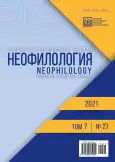Translation features of media articles about COVID-19 in Chinese in the linguo-pragmatic aspect
- 作者: Gorobtsov E.V.1, Mitchell P.J.2
-
隶属关系:
- National Research Tomsk State University
- Derzhavin Tambov State University
- 期: 卷 7, 编号 27 (2021)
- 页面: 453-459
- 栏目: ЯЗЫКОЗНАНИЕ
- URL: https://journal-vniispk.ru/2587-6953/article/view/302428
- DOI: https://doi.org/10.20310/2587-6953-2021-7-27-453-459
- ID: 302428
如何引用文章
全文:
详细
In the age of information, media language takes on special importance. Its continuous development is linked primarily to the evolution of information transfer technologies, which provide media language a special role as a model of national language in the information space. Media speech influences language norms, tastes and preferences of native speakers more than official, academic or artistic speech. The study of media texts as a result of speech immersed in a specific social context may help to examine in greater detail the basic principles of certain spheres of life. This, in addition to considering the translation of media articles and its linguistic and pragmatic features, can form the basis for further linguistic research, and additionally is especially relevant in light of the global emergency caused by the COVID-19 pandemic. In this work the linguistic and pragmatic translation features of media texts were considered on the basis of media texts on COVID-19 in Chinese. By analyzing these articles, data on the structure and characteristics of media texts and media language are proposed, which can help to delve deeper into the specifics of media language and the translation of media texts; analysis of the translation of media articles from Chinese into Russian is also conducted.
作者简介
E. Gorobtsov
National Research Tomsk State University
Email: efugen@yandex.ru
ORCID iD: 0000-0003-0565-2916
Assistant of Translation and Language Communication Department
36 Lenin St., Tomsk 634050, Russian FederationP. Mitchell
Derzhavin Tambov State University
编辑信件的主要联系方式.
Email: peter_mitchell@mail.ru
ORCID iD: 0000-0001-9228-903X
Doctor of Education (University of Derby, Derby, Great Britain); Professor, Head of Translation and Language Communications Department of Foreign Languages Faculty, Head of the International Master’s Degree Programme “Global MA in ELT Leadership”,Professor of Linguistics and Humanities and Pedagogical Education Department, Active Member of the Institute of Linguists of Great Britain
33 Internatsionalnaya St., Tambov 392000, Russian Federation参考
- Aleyevskaya A.O. Yazyk SMI kak indikator sotsial’nykh peremen [Mass media language as an indicator of social changes]. Aktual’nyye voprosy sovremennoy filologii i zhurnalistiki – Actual Issues of Modern Philology and Journalism, 2015, no. 3 (17), pp. 122-129. (In Russian).
- Shabelnik A.V. Pragmaticheskoye soderzhaniye tekstov SMI v metodike obucheniya studentov-zhurnalistov [Pragmatic content of the text media in teaching methods for journalism students]. Sovremennyye problemy nauki i obrazovaniya – Modern Problems of Science and Education, 2015, no. 1-2, pp. 121. (In Russian).
- Gao Xin Poryadok slov i aktual’noye chleneniye v kitayskom yazyke v zerkale russkogo yazyka [Word order and actual articulation in the Chinese language in the mirror of the Russian language]. Sbornik nauchnykh publikatsiy inostrannykh i rossiyskikh aspirantov i doktorantov filologov «Golosa molodykh uchenykh» [Collection of Scientific Publications of Foreign and Russian Graduate and Doctoral Students of Philologists “Voices of Young Scientists”]. Moscow, 2005, Issue 17, pp. 125-134. (In Russian).
- Donchenko A.V. Priyemy perevoda frazeologicheskikh edinits kitayskogo yazyka [Methods of translating phra-seological units of the Chinese language]. Molodoy uchenyy – Young Scientist, 2015, no. 9 (89), pp. 1354-1357. (In Russian).
- Shepeleva A.V. Translation of phraseological units as means to realize pragmatic potential of English political mass media discourse. MNIZh – International Research Journal, 2018, no. 6-2 (72).
补充文件










